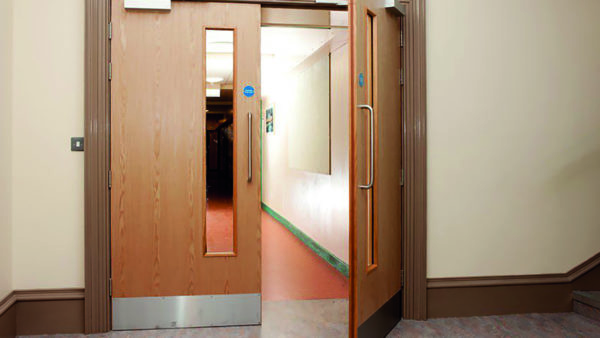
The Irish writer George Bernard Shaw said: “England and America are two countries separated by a common language.”
We certainly know that both the UK and the USA have a huge amount in common, but it is not just our language that we share. In both countries our industries provide high quality specification and supply of critical life safety products in ironmongery/hardware and we both have sets of standards that we faithfully use, promote and help create, so this article will detail what the key standards are, and the process of how they are created.
Standards Developing Organisations
A Standards Developing Organisation (SDO) can be defined as an organisation whose primary function is developing, coordinating, promulgating, revising, amending, reissuing, interpreting, or otherwise producing technical standards to address the needs of a group of affected adopters. In UK we are well acquainted with organisations such as CEN ( Comité Européen de Normalisation/ European Committee for Standardisation) and BSI (British Standards Institution). In the USA some of the equivalent SDOs include ANSI (American National Standards Institute), BHMA (Builders Hardware Manufacturers Association), UL (Underwriters Laboratory) and NFPA (National Fire Prevention Association).
In the same way that the BSI has a long history, having been established in 1901with over 40,000 standards, many of these SDOs can claim similar longevity. UL produced its first standard in 1903 for Tin Clad Fire Doors and ANSI was founded in 1918 and now have a catalogue of over 9,500 standards. BHMA started in 1925 and is the only SDO accredited by ANSI to develop and maintain over 40 hardware performance standards. NFPA can trace its origins back to 1896 and is a global self-funded non-profit organisation, devoted to eliminating death, injury, property, and economic loss due to fire, electrical and related hazards with more than 300 consensus codes and standards in its portfolio.
Product standards and building safety codes
Similar to EN and BS standards, many ANSI/BHMA standards define different product grades for a particular hardware item. ANSI/BHMA product grades as 1, 2, or 3 – grade 1 is the highest – and these are defined by progressive levels of performance benchmarks in each applicable standard. These standards establish requirements for cycle tests, strength tests, operational tests, material evaluation tests, finish tests, and dimensional criteria for the products in the standard.
While the performance requirements of most products’ standards are fairly stringent and not easily passed by products of lesser quality design or workmanship, they are also viewed by many in the US market as “minimum standards” and are therefore not always seen as being very meaningful. For example, when every Grade 1 Mortise Lock available on the market is certified to the BHMA/ANSI standard, it can be viewed as a minimum standard since there is no differentiator. Therefore, manufacturers will often test their products beyond the stated performance requirements of the applicable standard for marketing purposes and advertise that as such, i.e. “our door closer is cycle tested to 10 million cycles, five times greater than the ANSI Grade 1 standard”.
In the UK and Europe, we are all extremely familiar with our own sets of British (BS) and European (EN) Standards and the same is equally true in the USA, although these are prefaced depending on the author of the standard such as A for ANSI and UL for Underwriters Laboratory.
Below is a table which details global standards for various items of hardware, but it is important to reiterate that the requirements within each standard are not necessarily the same and in fact may conflict in some ways. UL also has standards for certain products, as noted in the chart, and these standards focus on the fire and safety (egress) integrity of products.
As is done in the UK and Europe, manufacturers submit their products for independent testing to these performance standards, which can be supervised by testing laboratories who certify them to the corresponding BHMA/ANSI standard if they properly pass the tests. This testing and certification process is completely optional for manufacturers to have their products installed and used, but is typically necessary in order to sell them in the market as they stand as an independent testament to the products’ performance capabilities. Building codes do not require BHMA/ANSI certified products, although codes such as UL10C is referenced in NFPA 101 and 80 which in turn are referenced in International Building Codes.
- NFPA 101 is a hugely influential US Life Safety Code which can be used in conjunction with a building code or alone in jurisdictions that do not have a building code in place. It is used by numerous federal government agencies and provides minimum requirements for safety from fire and smoke emergencies and to allow prompt escape for occupants from the building in to a safe area within the building. It is most widely used source for strategies to protect people based on building construction, protection, and occupancy features that minimize the effects of fire and related hazards. Closest equivalents to NFPA 101 in UK is BS 9999 and BS 9991 which are codes of practice for fire safety in thee design, management and use if both commercial and residential buildings. Other influential NFPA standards include:
- NFPA 80 which regulates the installation and maintenance of assemblies and devices used to protect openings in walls, floors, and ceilings against the spread of fire and smoke within, into, or out of buildings.
- NFPA 105 prescribes minimum requirements for smoke door assemblies for use in providing safety to life and protection of property from smoke.
- NFPA 252 outlines methods of fire testing door assemblies that testing laboratories and manufacturers can use to determine the degree of fire protection provided by such assemblies and assess their suitability when fire resistance of a specific duration is required.
These standards all are massively co-dependent as NFPA 101 requires compliance with NFPA 80 and NFPA 105, and NFPA 252 is referenced in both NFPA 80 and NFPA 105.
Fire testing standards
In UK and Europe, we are highly familiar with standards for testing of fire doors such as BS 476 22 and EN 1634 1 & 2. The USA has its own set of standards in this area too and US fire rated doors are tested in accordance with the following standards:
- UL 10C, Positive Fire Pressure Tests of Door Assemblies. This code is a method of testing fire doors that more accurately simulates the conditions of a real fire. It establishes the neutral pressure level at a maximum of 40 inches above the sill after five minutes.
- UL 10B, Fire Tests of Door Assemblies (neutral or negative pressure)
- NFPA 252, Standard Methods of Fire Tests of Door Assemblies. The hugely influential International Building Code, which is adopted throughout 50 US states, requires swinging doors to be tested to UL10C or NFPA 252 with positive pressure testing. In addition to the fire testing a hose stream portion of the UL 10C and NFPA 252 tests the structural durability of the assembly.
Differences in product specification
A typical hardware specification in US would be very different from its counterpart in the UK or Europe. Building Codes and standards have a marked influence on what can and cannot be specified in each region. Here are some of the differences which can be seen:
- Corridor fire doors in US tend to use more fire exit hardware (exit devices) then in the UK due to their latching capabilities. In the UK these are more traditionally specified on final escape doors.
- Push plate/pull handle combinations or back-to-back pull handles, frequently specified in the UK, would not be specified on fire rated doors in the US as fire rated doors must be positively latched.
- Automatic flush bolts are more popular in US than in the UK although on double doors which are fire doors for habitable rooms, manual bolts are still used on rooms that are not normally occupied or where they are allowed by the Authority Having Jurisdiction.
We may be divided by a common language, but both regions are united in the promotion of high-quality hardware and ironmongery specifications.








